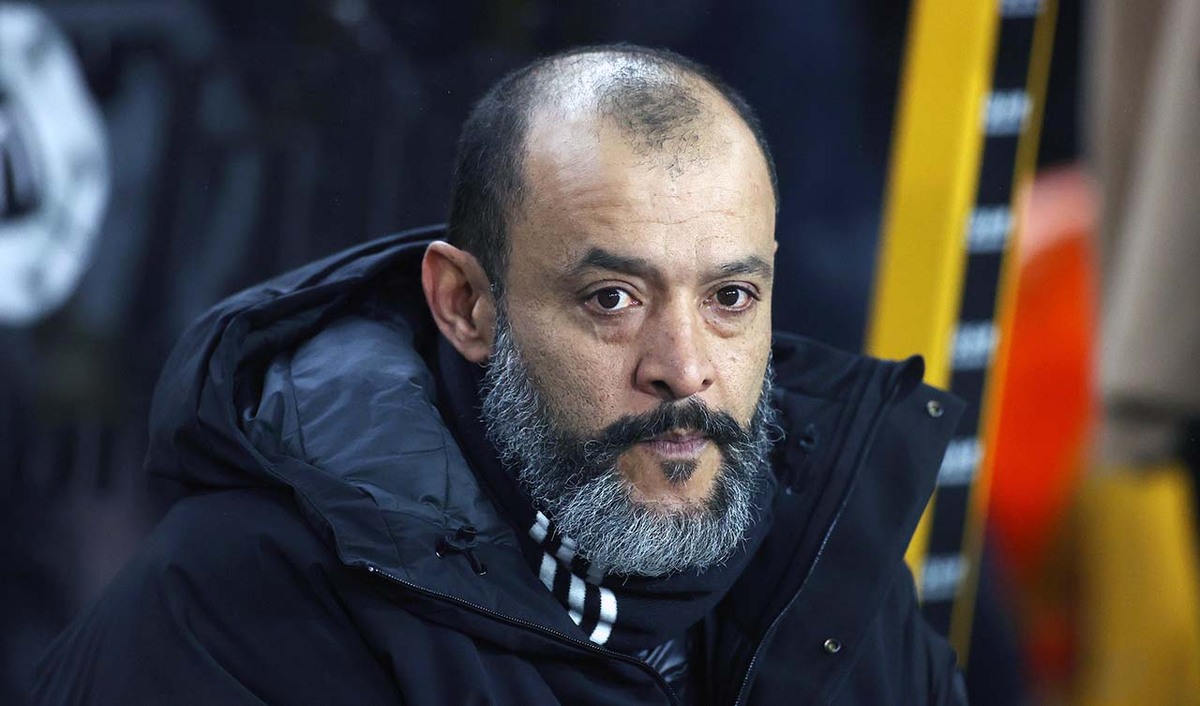You are viewing 1 of your 1 free articles
Team finishing
Put simply, this is a finishing session, but as it unfolds and progresses it becomes so much more than that. It allows us to devote time to all of the players – practising and repeating specific actions that will be asked of them in a match situation. We can adjust how we use this session, as not only can it be used to work on specific movements, combinations and relationships within the team, but it can also be used on a more relaxed training day in order to give more simple training time...
| Area | Half a pitch |
| Equipment | Balls, bibs, cones, 4 mannequins, 6 inflatable mannequins, 2 full size goals |
| No. of Players | Up to 18 players + 2 goalkeepers |
| Session Time | Combination play & Crossing drill: 12mins, Progressions: 18mins, 10v8 game: 20mins |
To put it simply, this is a finishing session, but as it unfolds and progresses it becomes so much more than that. It allows us to devote time to all of the players – practising and repeating specific actions that will be asked of them in a match situation.
We can adjust how we use this session, as not only can it be used to work on specific movements, combinations and relationships within the team, but it can also be used on a more relaxed training day in order to give some more simple training time.
As it’s a very adaptable exercise, this means we can utilise it on different training days for different objectives, whether it is to develop specific offensive movements, or for the players to practise more freely and show us their own actions and their own solutions.
What do I get the players to do?
We get players to run the following two drills. For the order of play, see the box below.
Pattern A: Combination play
We set up on half a pitch, with a goal and a goalkeeper at each end. A full size penalty area is marked out in front of each goal. Four standard mannequins are positioned on the flanks and three inflatable mannequins are lined up along the edge of each penalty area, as shown [1a].
1a
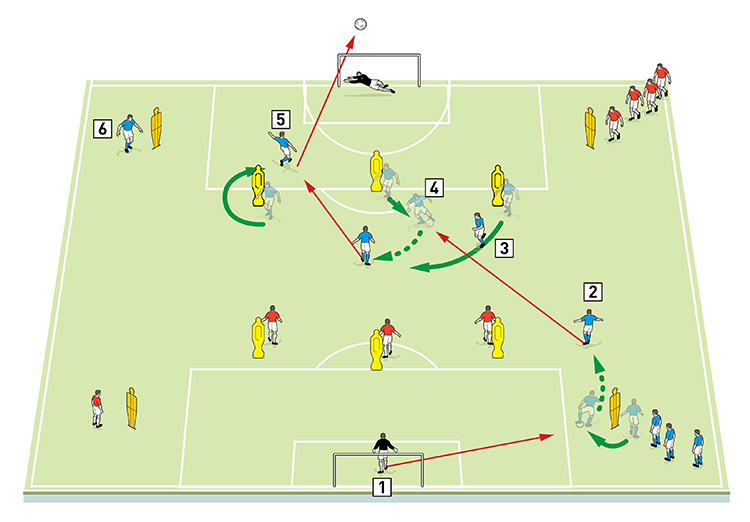
2. The full back receives, breaks forward with the ball and plays a pass to the central striker
3. The right-sided attacker makes a supporting run
4. The central striker receives with his back to goal and plays a carefully weighted through ball
5. The left-sided attacker spins off the mannequin and runs on to the through ball to score
6. Next the blues immediately run Pattern B, starting with a pass from the bottom keeper to the left winger (see next diagram)
We’re using 16 outfield players, split into two teams of eight. Each team has four players on one mannequin and one player on the mannequin diagonally opposite, plus a striker on each of the three inflatables in front of the goal they are attacking.
Play starts with the keeper passing to the queue of blues on the mannequin in the right back position. The first player receives, dribbles forwards and then passes to the central striker. The striker receives the ball with his back to goal, while the other two strikers make supporting runs. The central striker spins and plays a through ball into the path of his team mate, who has spun off the inflatable to make a well-timed run into the penalty area to take a shot at goal.
After one attack, the blue goalkeeper immediately launches a second attacking drill – Pattern B – using a second ball.
Pattern B: Crossing drill
As soon the blues have attacked once using the Combination Play drill, they then immediately start to run this Crossing Drill using a second ball.
The goalkeeper initiates play with a direct ball to the single left winger on the mannequin in the attacking half, as shown [1b]. The nearest attacker spins off the inflatable and plays a one-two with the winger, beating the mannequin as if it was a defender. The winger receives the return pass and crosses into a specific zone in front of goal. The central striker has made a run into the box to meet the cross, while the other attacker has made a late back post run.
After the blues have attacked using both patterns, then run both drills in the opposite direction with the reds, starting with a pass from the top goalkeeper to the first of the waiting red left backs.
Repeat so every player gets a turn. Rotate teams so players get the chance to cross from both sides.
1b
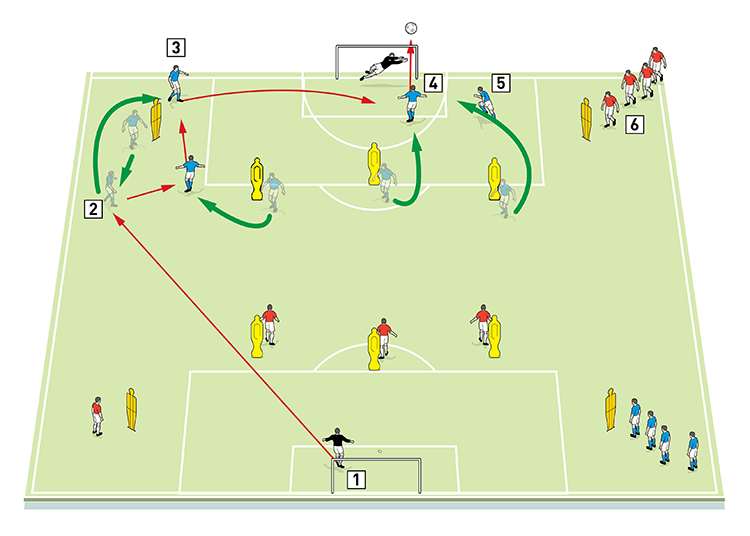
2. The winger receives and plays a wall pass with the nearest attacker
3. The winger runs on to the return ball and crosses into specific zones in front of goal
4. The central striker makes a run to attack the cross
5. The other attacker makes a late run to the back post to support play
6. Next run both drills in the opposite direction using the reds, starting with a pass from the top goalkeeper to the red left back
How do I progress the session?
We get players to run the following drills. For the order of play, see the box-out below.
Pattern C: Crossing drill progression
We progress the session by running a variation of the movement from both previous drills, with extra players and additional build up play. Using the same basic set-up, each team now has two full backs and two wingers on mannequins diagonally opposite each other, plus two central defenders or centre midfielders in the penalty area.
The goalkeeper starts play by passing out to the blue right back, who builds up play through the two central defenders, as shown [2a]. They combine to work the ball to the left winger and he repeats the movement from the previous drill to beat the mannequin and cross into the penalty area. One of the two opposition central defenders can work with the keeper to defend the cross, as two attackers make their runs into the box and try to score.
2a
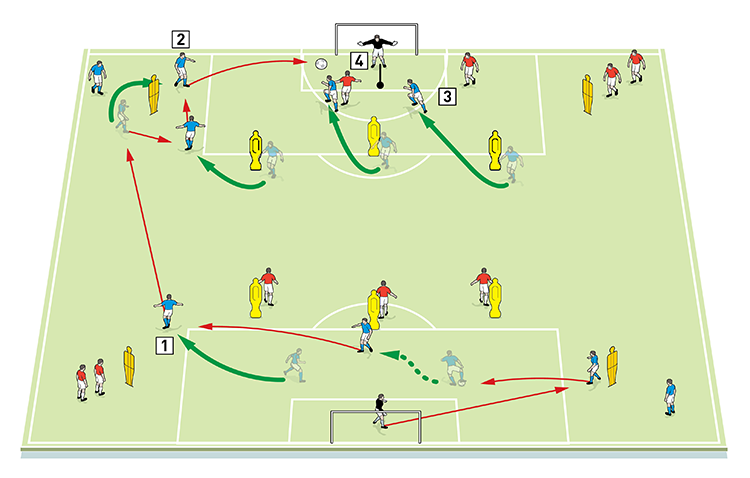
2. The winger combines with a team mate to beat the mannequin and crosses the ball
3. Two strikers make runs to attack the cross
4. One opposition centre back is active and works with the keeper to defend the cross
Pattern D: Combination play progression
After the blues have run the Crossing Drill Progression once, they then launch a progression of the Combination Play drill, with the blue right back this time combining with the central defender to play the ball up to the central striker, who is again supported by two other attackers, as shown [2b].But this time the centre forward is up against one active red defender, who tries to stop him scoring.
2b

2. The right back combines with a centre back and passes up to the central striker
3. The central striker works with the supporting attackers to play one of them in for a shot on goal
4. One of the opposition central defenders is active and can try to defend the attack
After the blues have attacked once using each of the progressions, run both drills (patterns C and D) in the opposite direction with the reds, starting with a pass from the goalkeeper to the left back – and then keep repeating the two patterns with each team.
How would I put this into a game situation?
We set up on half a pitch with an unopposed 10-yard channel on each flank. We have a goal and goalkeeper at each end. We’re using 18 outfield players, divided into a blue team of ten and a red team of eight. It’s 6v6 in the main area but the blues have two supporting wide players at the attacking end of each channel, while the reds have just one supporting wide player in each channel, as shown [3].
The idea is to replicate the movement, attacking runs, build up play and combinations of the earlier drills, with the blues having the obvious advantage of extra support players in the channel who can combine with team mates to create the space to cross into the penalty area.
If the ball goes out of play, restarts are from the goalkeeper.
3
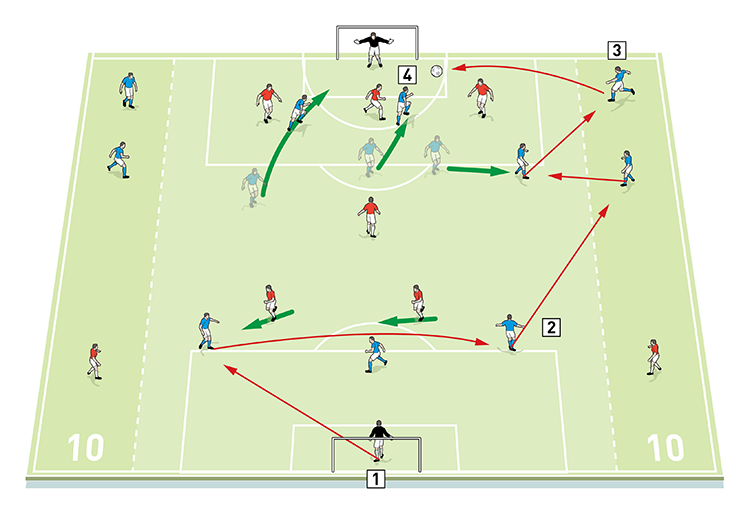
2. It’s 6v6 in the main area and the blues build play from the back
3. The blues have the advantage of two extra players in the unopposed wide channels. These can support play from outside and use combinations to create the space to cross
4. The central striker beats the defender to attack the cross
What are the key things to look out for?
What we want to see is the dynamics, the co-ordination between players – how they interpret the movement, how they can adjust and synchronise their actions to be able to execute the attack with the speed and precision that the Premier League demands.
What are the typical mistakes that players might make, and how do I avoid them?
Every single action must be valued. If any part of the session goes out of timing, an attack can fail – for instance, a bad touch can force our play to slow down and then the space we wanted to use has now been closed.
No single action makes the difference, as it’s every single action connected together that makes the difference. The trick is to make the players understand this.
Related Files
Editor's Picks
Deep runs in the final third
Using the goalkeeper in build-up play
Pressing principles
Intensive boxes drill with goals
Penetrating the final third
Creating and finishing
My philosophy
Pressing initiation
Compact team movement
Coaches' Testimonials

Alan Pardew

Arsène Wenger

Brendan Rodgers

Carlos Carvalhal

José Mourinho

Jürgen Klopp

Pep Guardiola

Roy Hodgson

Sir Alex Ferguson

Steven Gerrard
Coaches' Testimonials

Gerald Kearney, Downtown Las Vegas Soccer Club

Paul Butler, Florida, USA

Rick Shields, Springboro, USA

Tony Green, Pierrefonds Titans, Quebec, Canada
Join the world's leading coaches and managers and discover for yourself one of the best kept secrets in coaching. No other training tool on the planet is written or read by the calibre of names you’ll find in Elite Soccer.
In a recent survey 92% of subscribers said Elite Soccer makes them more confident, 89% said it makes them a more effective coach and 91% said it makes them more inspired.
Get Monthly Inspiration
All the latest techniques and approaches
Since 2010 Elite Soccer has given subscribers exclusive insight into the training ground practices of the world’s best coaches. Published in partnership with the League Managers Association we have unparalleled access to the leading lights in the English leagues, as well as a host of international managers.
Elite Soccer exclusively features sessions written by the coaches themselves. There are no observed sessions and no sessions “in the style of”, just first-hand advice delivered direct to you from the coach.
